Key in a search term below to search our website.
Key in a search term below to search our website.
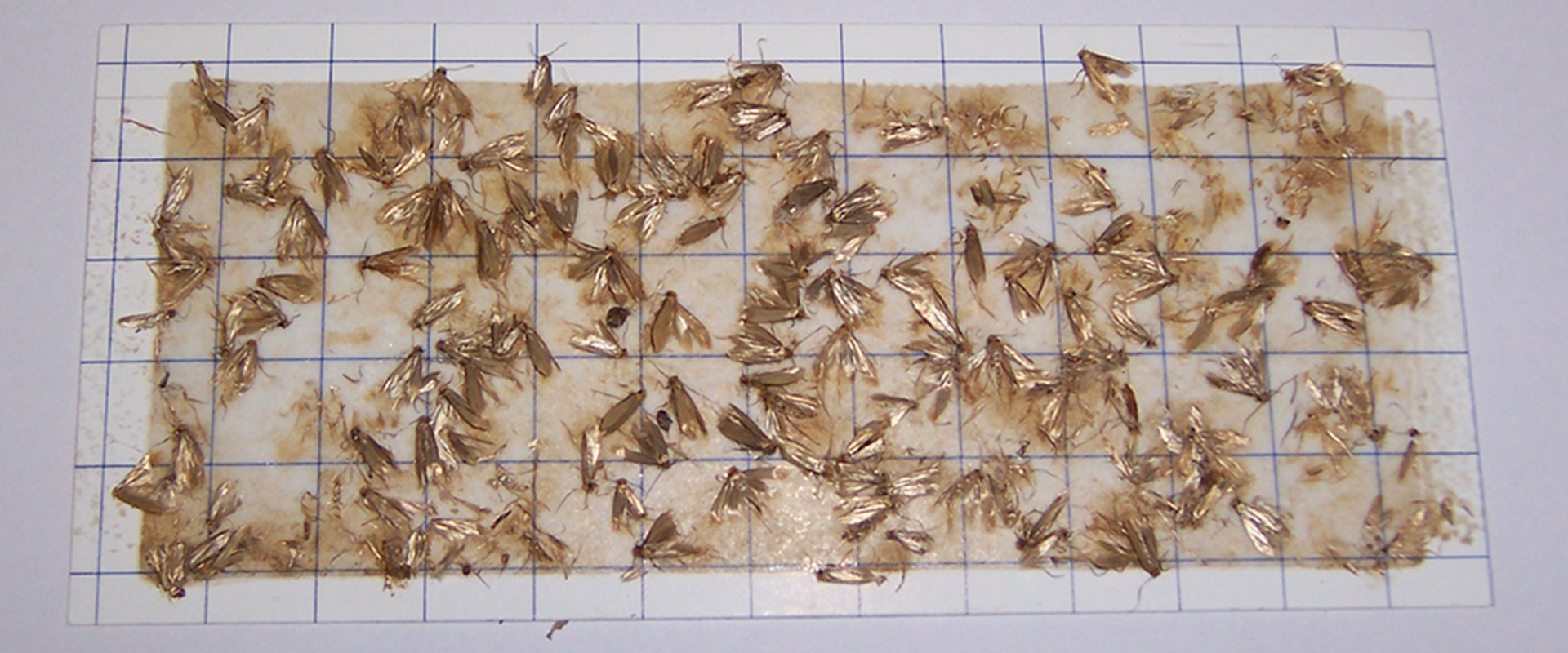
Infestations are much easier and cheaper to deal with if you catch them early. A good pest monitoring programme can help you to do this and also help with identifying the source of the problem.
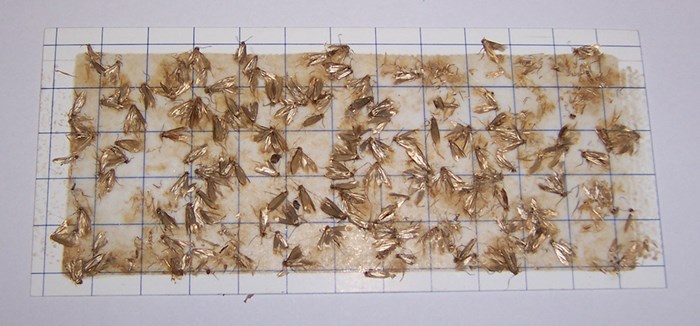
A Pheromone trap full of webbing clothes moth
Monitoring pests across your building or estate is a big job. Everyone who works with you can play a role acting as your eyes and ears watching for and reporting pests. Consider colleagues working in different areas where monitoring pests is key. Offer these colleagues short training sessions or tool box talks on what to look for and why. Pictures of damaged objects are a good way to get the message across!
At National Museums Scotland, we’ve implemented the ‘pest desk'. This is an email address where anyone who sees an insect or rodent can email with details. Emails are received by our Preventive conservation and Estates teams who record the findings and investigate as appropriate. Everyone who works at National Museums Scotland is reminded about the pest desk annually.
In addition, we provide targeted pest identification training to colleagues working in specific areas. This includes Visitor Experience colleagues invigilating galleries, curators working in stores, and colleagues working with shop stock.
Monitoring insects with traps can be very effective. Sticky (or blunder) traps should be positioned throughout buildings. Placement of the traps is important to maximise their ability to catch a representative sample of any insect populations present. Traps should be placed:
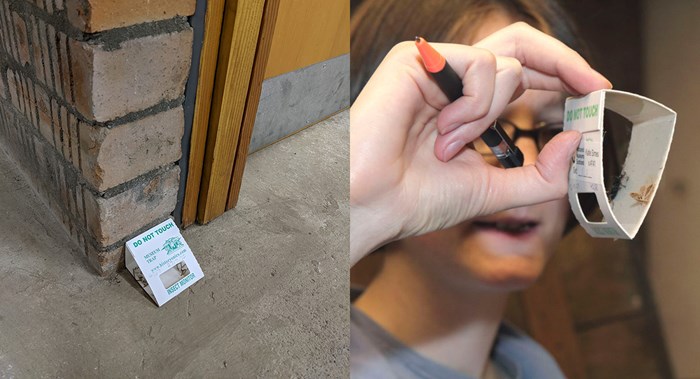
Preventive conservation staff checking blunder traps
Pheromone traps can also be purchased, these traps are species specific and can be useful if you suspect or have a problem with a particular species.
These should be placed according to the manufacturer's instructions as, depending on the species, there may be certain conditions in which you will maximise catches, for example height from the floor.
Pheromone traps also have a finite life so may need replacing more regularly than a standard blunder trap to continue to be effective.
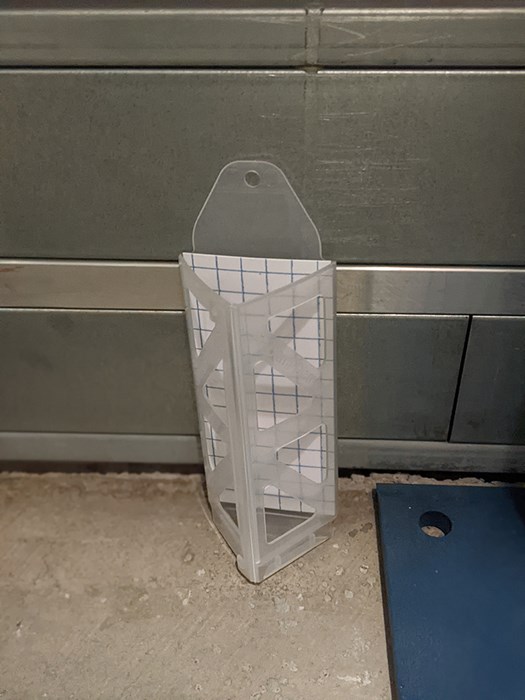
Webbing clothes moth pheromone trap
A readily available pheromone trap is one for common clothes moth - a pest many museums find in their collections. These traps should be placed no higher than hip height and preferably in dark corners as common clothes moths do not like the light. If you can anticipate where the pest is likely to be you will maximise your chances of finding it.
It is important to number and document where you place traps. This will ensure you can find them and accurately document what you find in them. Building maps, where you mark on the map the location and number of a trap, can help you do this.
Traps should be checked once per quarter, the most important times to check are spring and summer when activity is likely to be higher. Consider your resources in terms of cost of materials and staff time. If you find yourself short of time to complete checks, re-assess the number of traps you have. It is better to check a smaller number of traps at appropriate intervals, than to have lots that never get looked at. If traps become full with non-pest species (such as spiders and ground beetles) and unattended, these could become a food source for pests.
Documenting your finds from each quarterly pest check is incredibly important. It will allow you to hone in on problem areas and track issues over time. Remember, a negative result is significant (especially when using pheromone traps), as it can help to determine the time frame for the start of an infestation, which in turn may help to narrow down the source. At National Museums Scotland we document negative results as well as problem insects in each traps we check.
Photographic records of objects can be useful to determine if damage is new or historic.
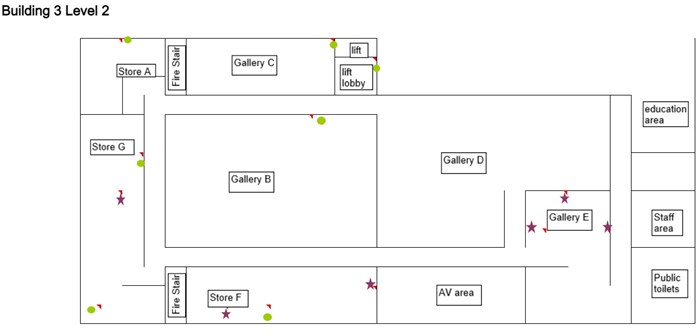
An example trap map
As well as formal monitoring and documenting, remember to look out for other signs of activity during your quarterly checks such as:
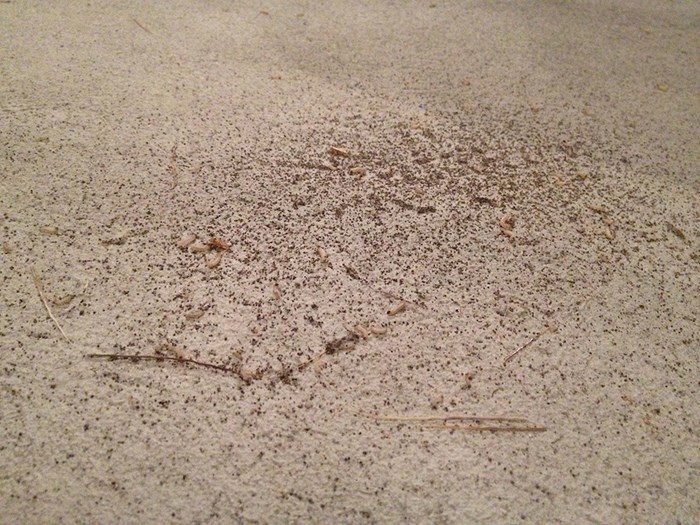
Example of frass and larvae found on a plinth
A map of your buildings (it doesn’t have to be to scale) is a useful tool for IPM. Mark it up with areas of risk (see below). For example, collections which could be food to sustain pests, known areas of damp or high temperature where pest could thrive, areas with minimal activity where pests could shelter as well as areas where people eat and/or store food. This map will allow you to focus your resources to monitor pest.
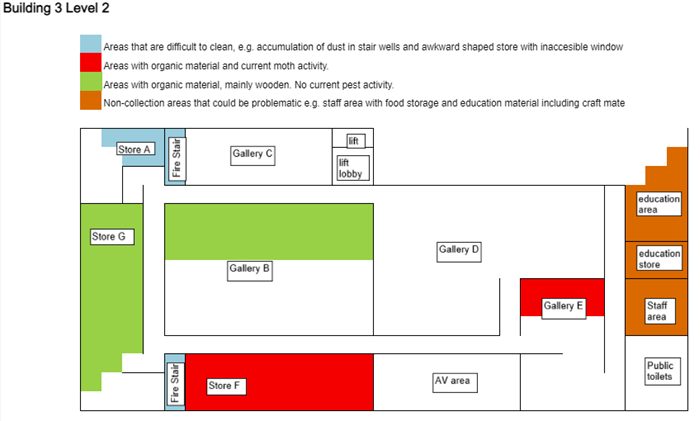
An example of a risk map
For issues with rodent infestation, it is best to work with an outside contractor who specialise in rodents. For this it is best to work with a contractor who understands your building and requirements. Always speak to your contractor before any work is carried out.
A Product of the Integrated Pest Management Working Group, this is the website for the American group of Heritage Pest professionals. They also have a Facebook page where they stream their conference.
A select bibliography of IPM publications and conference proceedings.
Birmingham Museums have developed this resource which includes advice and clear photos of insect pests, with examples of damage.
English Heritage offer advice and guidance on insect pests and have factsheets and posters with further information about different species.
This text by David Pinniger and Dee Lauder includes colour photos and case studies.
Written by David Pinniger, this is another key text on the subject with clear drawings and good, practical advice about setting up a pest monitoring programme.
- Birmingham Museums have a very good website called What’s Eating Your Collections? This has lots of advice and clear photos of insect pests, with examples of damage.
- English Heritage offer advice and guidance on insect pests and have some very good factsheets and posters with further information about different species.
- ‘Pests in Houses Great and Small’ by David Pinniger and Dee Lauder: this is a key text with some good colour photos and case studies.
- ‘Pest Management in Museums, Archives and Historic Houses’ by David Pinniger is another key text on the subject with clear drawings and good, practical advice about setting up a pest monitoring programme.
In addition to this self-guided training we provide other services including webinars to give you an opportunity to ask questions and meet our experts. Please contact us for more information.
Email partnerships@nms.ac.ukThese training pages are licensed for reuse under a Creative Commons Attribution-NonCommercial-ShareAlike 4.0 International License.
We are delighted for you to reuse, build on and publish the training content in these pages for non-commercial purposes. When you do, we ask that you credit National Museums Scotland and share the content under the same licensing terms.